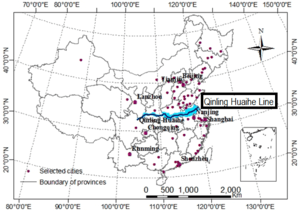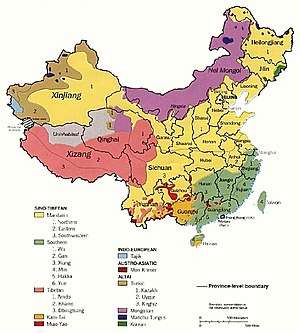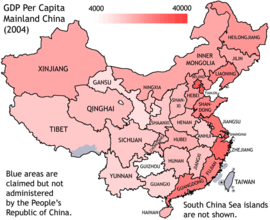Northern and southern China
Northern China (Chinese: 中国北方 or 中国北部; lit.: 'China's North') and southern China (Chinese: 中国南方 or 中国南部; lit.: 'China's South')[note 1] are two approximate mega-regions within China. The exact boundary between these two regions is not precisely defined. Nevertheless, the self-perception of Chinese nation, especially regional stereotypes, has often been dominated by these two concepts, given that regional differences in culture and language have historically fostered strong regional identities of the Chinese people.[1]

Extent
Often used as the geographical dividing line between northern and southern China is the Qinling–Huaihe Line (lit. Qin Mountains–Huai River Line). This line approximates the 0 °C January isotherm and the 800 millimetres (31 in) isohyet in China.
Culturally, however, the division is more ambiguous. In the eastern provinces like Jiangsu and Anhui, the Yangtze River may instead be perceived as the north–south boundary instead of the Huai River, but this is a recent development.
There is an ambiguous area, the region around Nanyang, Henan, that lies in the gap where the Qin has ended and the Huai River has not yet begun; in addition, central Anhui and Jiangsu lie south of the Huai River but north of the Yangtze, making their classification somewhat ambiguous as well. As such, the boundary between northern and southern China does not follow provincial boundaries; it cuts through Shaanxi, Henan, Anhui, and Jiangsu, and creates areas such as Hanzhong (Shaanxi), Xinyang (Henan), Huaibei (Anhui) and Xuzhou (Jiangsu) that lie on an opposite half of China from the rest of their respective provinces. This may have been deliberate; the Yuan dynasty and Ming dynasty established many of these boundaries intentionally to discourage anti-dynastic regionalism.
The Northeast and Inner Mongolia are conceived to belong to northern China according to the framework above. At some times in history, Xinjiang, Tibet and Qinghai were not conceived of as being part of either the north or south. However, internal migration, such as between the Shandong and Liaodong peninsulas during the Chuang Guandong period, have increased the purview of "north" China to include previously marginalized areas.
History
The concepts of northern and southern China originate from differences in climate, geography, culture, and physical traits; as well as several periods of actual political division in history. Northern China is too cold and dry for rice cultivation (though rice is grown there today with the aid of modern technology) and consists largely of flat plains, grasslands, and desert; while Southern China is warm and rainy enough for rice and consists of lush mountains cut by river valleys. Historically, these differences have led to differences in warfare during the pre-modern era, as cavalry could easily dominate the northern plains but encountered difficulties against river navies fielded in the south. There are also major differences in cuisine, culture, and popular entertainment forms such as opera.

Episodes of division into North and South include:
- Three Kingdoms (220–280)
- Sixteen Kingdoms (317–420) and Southern and Northern Dynasties (420–589)
- Five Dynasties and Ten Kingdoms period (907–960)
- Southern Song dynasty (1127–1279) and Jin dynasty (1115–1234)
- Warlord era (1916–1928) of the Republic of China
During and after the Qing dynasty are few regional-based rebellions which include:
- South
- Taiping Rebellion (1850–1864)
- Xinhai Revolution (1911–1912)
- National Protection War (1915–1916)
- North
- Chinese Civil War (1946–1950) (after World War II)
The Northern and Southern Dynasties showed such a high level of polarization between North and South that northerners and southerners referred to each other as barbarians; the Mongol Yuan dynasty also made use of the concept: Yuan subjects were divided into four castes, with northern Han Chinese occupying the third-caste and southern Han Chinese occupying the lowest one.
For a large part of Chinese history, northern China was economically more advanced than southern China . The Jurchen and Mongol invasion caused a massive migration to southern China, and the Emperor shifted the Song dynasty capital city from Kaifeng in northern China to Hangzhou, located south of the Yangtze river. The population of Shanghai increased from 12,000 households to over 250,000 inhabitants after Kaifeng was sacked by invading armies. This began a shift of political, economic and cultural power from northern China to southern China. The east coast of southern China remained a leading economic and cultural center of China until the Republic of China. Today, southern China remains economically more prosperous than northern China.
During the Qing dynasty, regional differences and identification in China fostered the growth of regional stereotypes. Such stereotypes often appeared in historic chronicles and gazetteers and were based on geographic circumstances, historical and literary associations (e.g. people from Shandong, were considered upright and honest) and Chinese cosmology (as the south was associated with the fire element, Southerners were considered hot-tempered).[1] These differences were reflected in Qing dynasty policies, such as the prohibition on local officials to serve their home areas, as well as conduct of personal and commercial relations.[1] In 1730, the Kangxi Emperor made the observation in the Tingxun Geyan (《庭訓格言》):[1][3]
The people of the North are strong; they must not copy the fancy diets of the Southerners, who are physically frail, live in a different environment, and have different stomachs and bowels.
— the Kangxi Emperor, Tingxun Geyan (《庭訓格言》)
During the Republican period, Lu Xun, a major Chinese writer, wrote:[4]
According to my observation, Northerners are sincere and honest; Southerners are skilled and quick-minded. These are their respective virtues. Yet sincerity and honesty lead to stupidity, whereas skillfulness and quick-mindedness lead to duplicity.
Today

In modern times, North and South is merely one of the ways that Chinese people identify themselves, and the divide between northern and southern China has been complicated both by a unified Chinese nationalism and as well as by local loyalties to linguistically and culturally distinct regions within province, prefecture, county, town and village isolates which prevent a coherent Northern or Southern identity from forming.
During the Deng Xiaoping reforms of the 1980s, South China developed much more quickly than North China, leading some scholars to wonder whether the economic fault line would create political tension between north and south. Some of this was based on the idea that there would be conflict between the bureaucratic north and the commercial south. This has not occurred to the degree feared, in part because the economic fault lines eventually created divisions between coastal China and the interior, as well as between urban and rural China, which run in different directions from the north–south division, and in part because neither north or south has any type of obvious advantage within the Chinese central government. In addition there are other cultural divisions that exist within and across the north–south dichotomy.
Stereotypes and differences
Nevertheless, the concepts of North and South continue to play an important role in regional stereotypes.
"Northerners" are seen as:
- Taller.[5][6][7] According to the 2014 census, the average male height between the age of 20-24 was 173.4 cm in Beijing,[8] 174.9 cm in Jilin province[9] and 177.1 cm in Dalian.[10]
- Speaking Mandarin Chinese with a northern (rhotic) accent.
- More likely to eat noodles, dumplings and wheat-based foods[7] (rather than rice-based foods).[6][11]
While "Southerners" are seen as:
- Shorter.[6][7] According to 2014 census, the average male height between the age of 20–24 was 173.3 cm in Shanghai,[12] 171.6 cm in Zhejiang province[13] and 171.9 cm in Fujian province.[14]
- Speaking Mandarin Chinese with a southern (non-rhotic) accent or speaking any southern Chinese language, such as those under Yue (e.g. Cantonese), Min (e.g. Hokkien), Wu (e.g. Shanghainese), Hakka, Xiang or Gan.
- More likely to eat rice-based foods (rather than wheat-based foods) and seafood.[6][7][11]
These are only rough and approximate stereotypes among a large and greatly varied population.
See also
- Cultural regions in China
- List of regions of China
- North China (Eastern Inner Mongolia is also part of Northeast Asia)
- Northeast China (also part of Northeast Asia)
- Southeast China
- East China (some geographers include the Taiwan Island, Penghu, Kinmen, Matsu Islands, and Senkaku Islands in this subregion)
- South Central China
- Central China
- South China (including the Hainan Island, Paracel Islands, and Zhongsha Islands; some geographers also include Hong Kong, Macau, and the Pratas Islands in this subregion)
- Western China
- Nanquan (Southern Fist)
- North China (disambiguation)
- North–South divide in Taiwan
- Northern and southern Vietnam
- South China (disambiguation)
- Wushu (Kung Fu)
- Zhonghua minzu
- Great Qing Famine
Notes
- Also referred to in China as simply the north (Chinese: 北方; pinyin: Běifāng) and the south (Chinese: 南方; pinyin: Nánfāng).
- The map shows the distribution of linguistic groups according to the historical majority ethnic groups by region. Note this is different from the current distribution due to age-long internal migration and assimilation.
References
Citations
- Smith, Richard Joseph (1994). China's cultural heritage: the Qing dynasty, 1644–1912 (2 ed.). Westview Press. ISBN 978-0-8133-1347-4.
- Source: United States Central Intelligence Agency, 1990.
- Hanson, Marta E. (July 2007). "Jesuits and Medicine in the Kangxi Court (1662–1722)" (PDF). Pacific Rim Report. San Francisco: Center for the Pacific Rim, University of San Francisco (43): 7, 10. Archived from the original (PDF) on 19 March 2012. Retrieved 12 July 2011.
- Young, Lung-Chang (Summer 1988). "Regional Stereotypes in China". Chinese Studies in History. 21 (4): 32–57. doi:10.2753/csh0009-4633210432. Archived from the original on 29 January 2013.
- Zhang, Xuan; Huang, Ze (July–August 1988). "The Second National Growth and Development Survey of Children in China, 1985: children 0 to 7 years". Annals of Human Biology. Informa Healthcare. 15 (4): 289–305. doi:10.1080/03014468800009761. PMID 3408235.
- Fodor's (2009). Kelly, Margaret (ed.). Fodor's China. p. 135. ISBN 978-1-4000-0825-4.
- Eberhard, Wolfram (December 1965). "Chinese Regional Stereotypes". Asian Survey. University of California Press. 5 (12): 596–608. doi:10.2307/2642652. JSTOR 2642652.
- 北京市2014年国民体质监测结果公报 Archived 17 April 2013 at the Wayback Machine, 北京市体育局
- 2014年吉林省第三次国民体质监测公报, 吉林省体育局
- Tang (唐), Ke (克). "大连人平均身高男177cm女165cm居全国前列-中国搜索大连". dl.chinaso.com. Retrieved 29 April 2018.
- Regions of Chinese food-styles/flavours of cooking, University of Kansas
- 2014年上海市第四次国民体质监测公报, 上海市体育局
- 2010年贵州省第三次国民体质监测公报, 贵州省体育局
- 福建省2014年国民体质监测公报, 福建省体育局
Sources
- Brues, Alice Mossie (1977). People and Races. Macmillan series in physical anthropology. New York, NY: Macmillan. ISBN 978-0-02-315670-0.
- Lamprey, J. (1868). "A Contribution to the Ethnology of the Chinese". Transactions of the Ethnological Society of London. Royal Anthropological Institute of Great Britain and Ireland. 6: 101–108. doi:10.2307/3014248. JSTOR 3014248.
- Morgan, Stephen L. (July 2000). "Richer and Taller: Stature and Living Standards in China, 1979–1995". The China Journal. Contemporary China Center, Australian National University. 44 (44): 1–39. doi:10.2307/2667475. JSTOR 2667475.
- Muensterberger, Warner (1951). "Orality and Dependence: Characteristics of Southern Chinese." In Psychoanalysis and the Social Sciences, (3), ed. Geza Roheim (New York: International Universities Press).
Further reading
- Ebrey, Patricia Buckley; Liu, Kwang-chang. (1999). The Cambridge Illustrated History of China. Cambridge University Press. ISBN 978-0-521-66991-7 (ch. 4, 5)
- Lewis, Mark Edwards. (2009). China Between Empires: The Northern and Southern Dynasties. Harvard University Press. ISBN 978-0-674-02605-6
- Tu, Jo-fu. (1992). Chinese Surnames and the Genetic Differences Between North and South China. Project on Linguistic Analysis, University of California, Berkeley.
